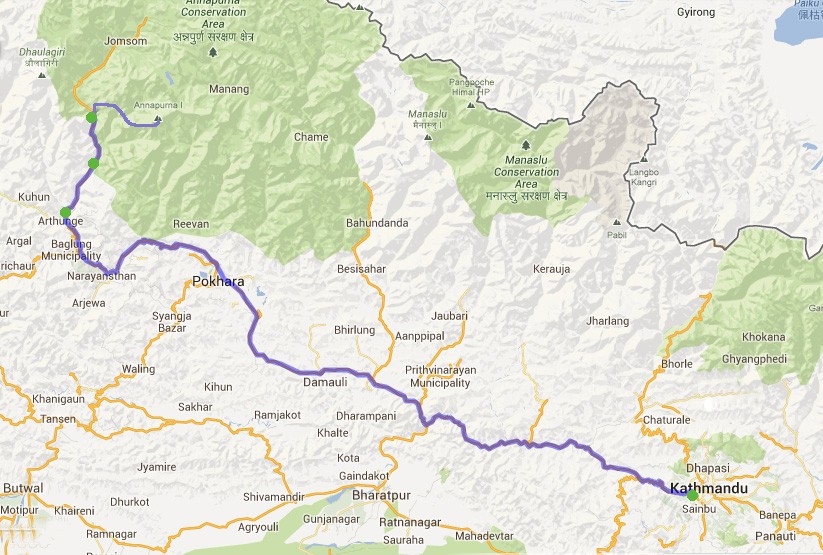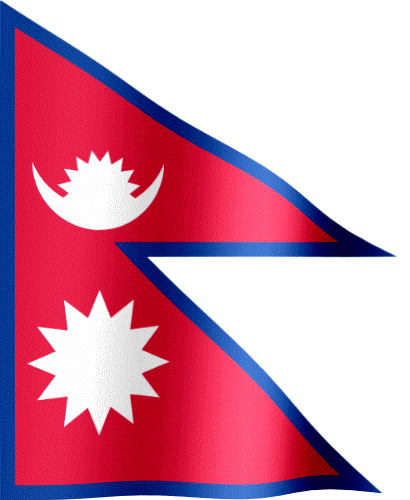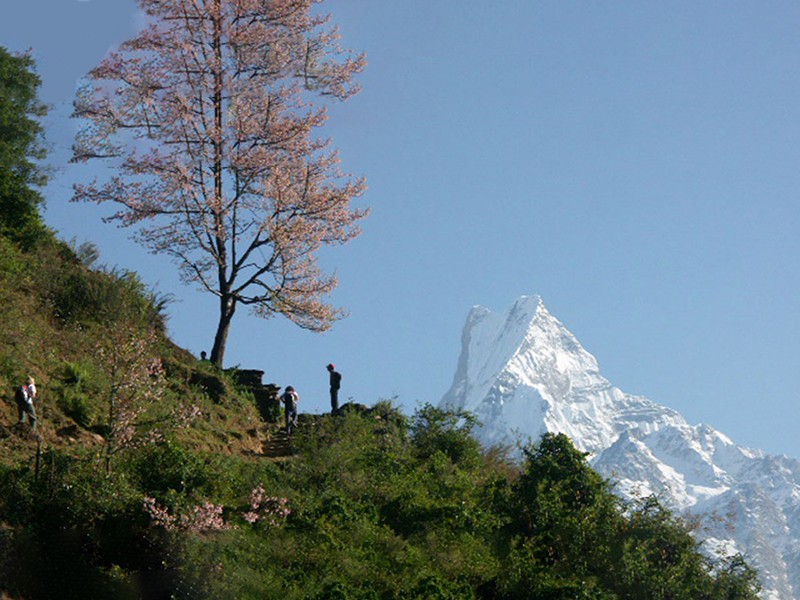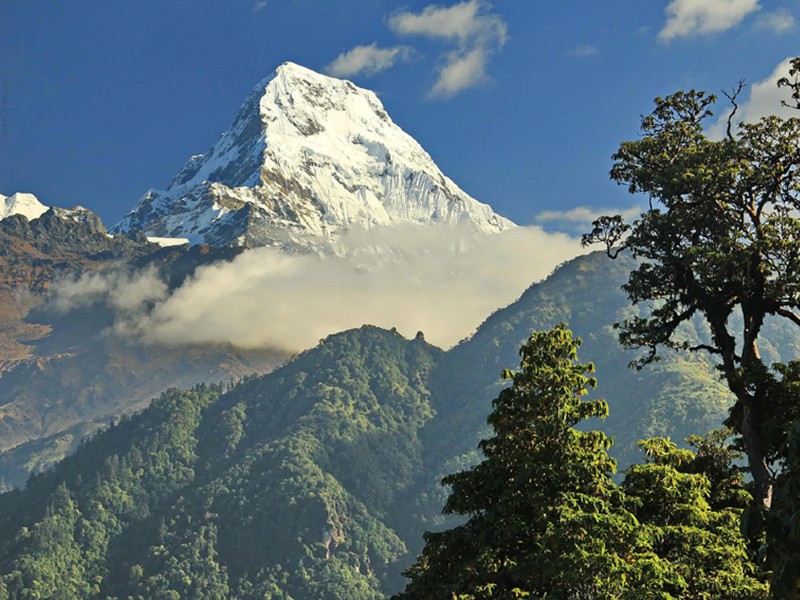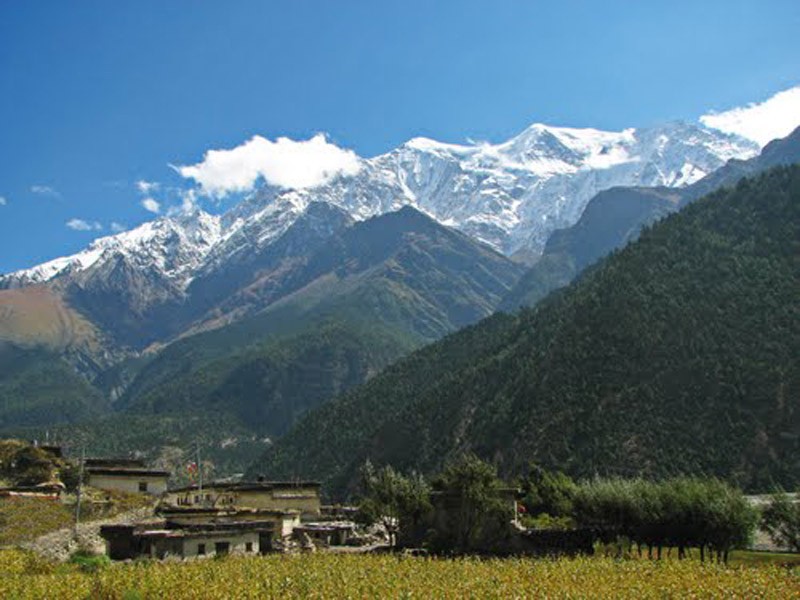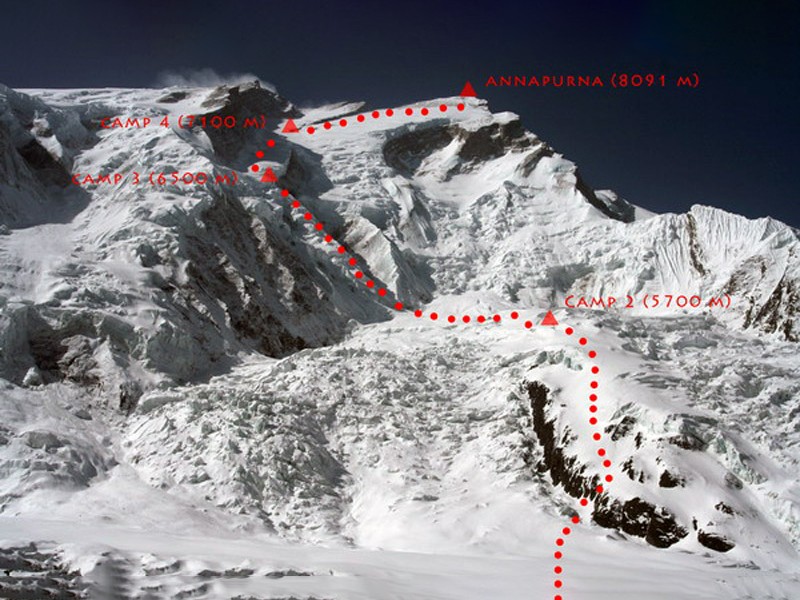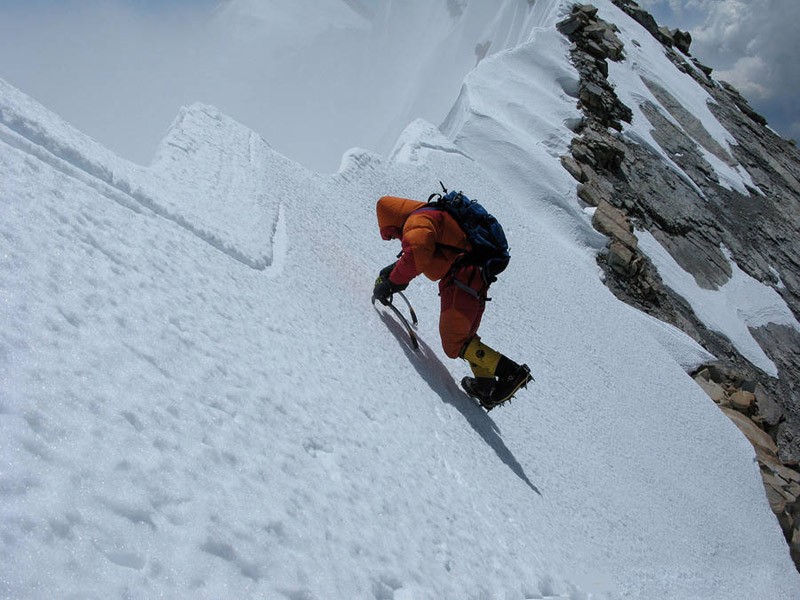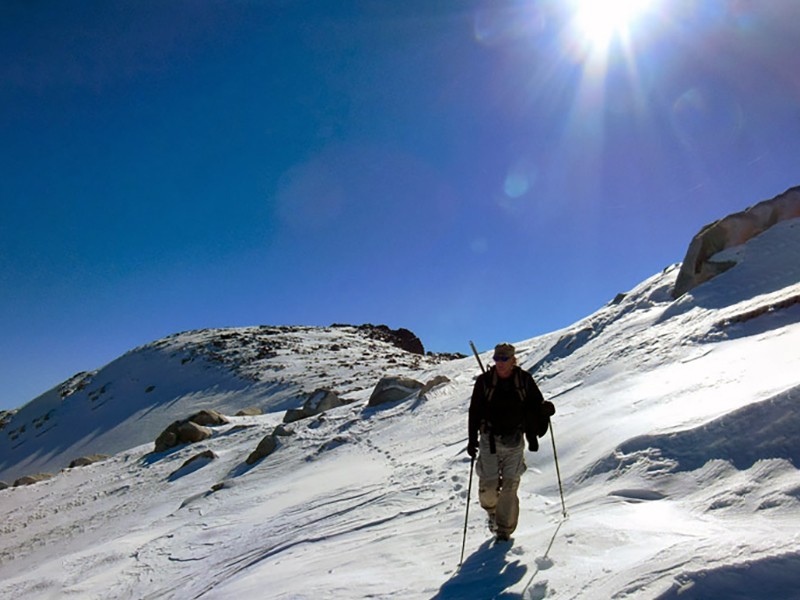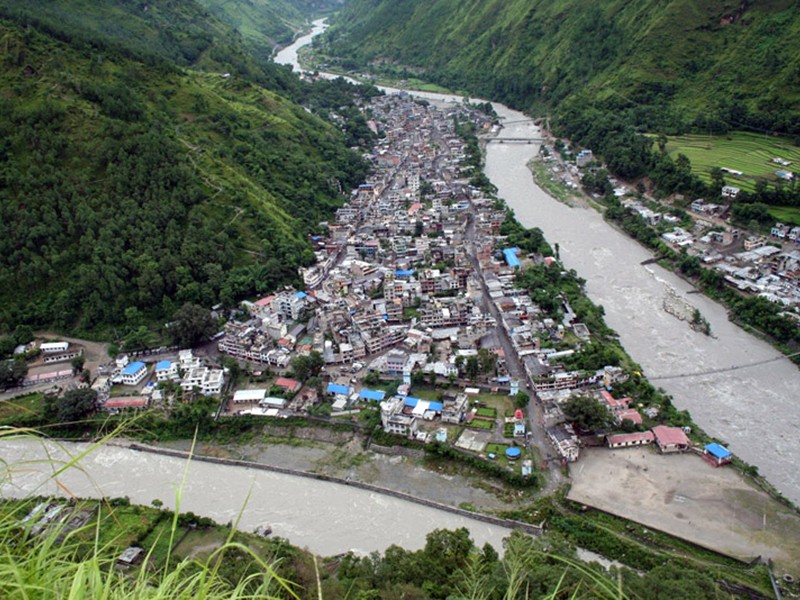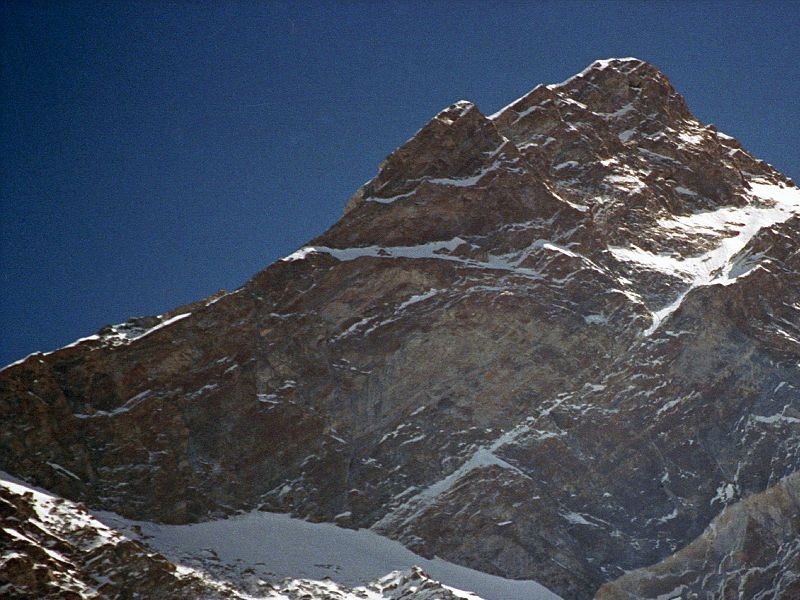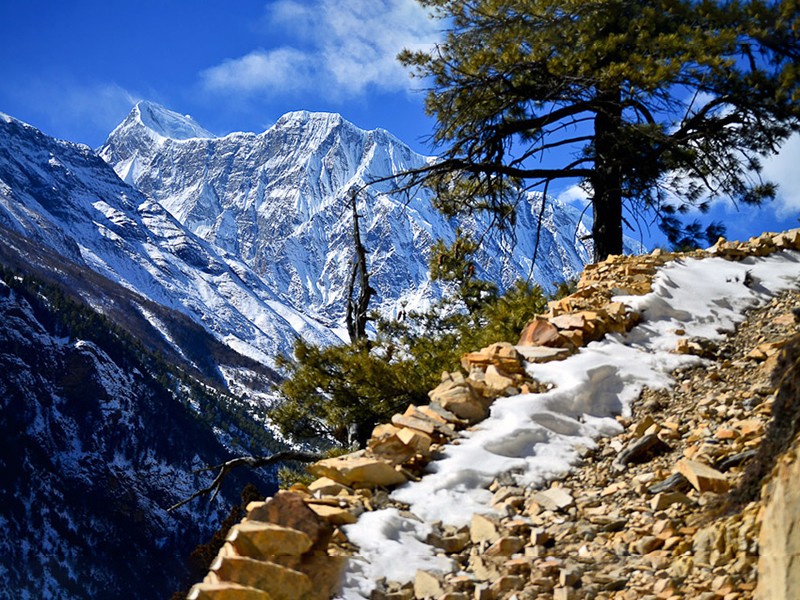Reference Code: MAENP
Trip Start: Kathmandu
Trek Start: Nayapul
Trek Days: 50 Days
Peak Climbing Period: 31 Days
Maximum Altitude: 8091m.
Age: 20 years to 60 years
Season: Spring and Autumn
Accommodation: Lodge and Camp
Service: Full board
Destination: Nepal
Trip End: Kathmandu
Trek End: Beni
Trip Durations: 56 Days
Peak Grade: Extreme
Physical Rating: Strenuous
Group Size: 4-12
Theme: Expedition
Meals: Standard
Mt. Annapurna Expedition I (8,091m.) is the 10th highest mountain in the world. Highest among the 55 kilometres long Annapurna massif comprising of more than 30 peaks. Mt. Annapurna Expedition is one of the first 8000 meters peaks to be climbed. The first successful ascent of Mt. Annapurna was made by Maurice Herzog and Louis Lachenal on June 3, 1950. Annapurna Conservation Area Project (ACAP) protects the entire Annapurna massif and the surrounding region. It is the first and largest conservation area in Nepal.
The fascinating mountains and forest areas make Annapurna region one of the popular destinations and most enchanting spot on this planet. Mt. Annapurna climbing is one of the most dangerous mountains to climb with high risks of avalanches. All the route possessing severe difficulties for climbers to overcome with huge ice cliffs and seracs. Hence, previous experience of peak climbing with a good physical condition is highly recommended for those seeking to achieve the summit of Annapurna I.
Day 01 Arrival in Kathmandu and transfer to hotel
Namaste! And welcome to Kathmandu, the colourful capital of Nepal where ornately carved balconies mingle with beautiful shrines and temples. Your adventure begins with a welcome meeting on arrival at the exit gate of Kathmandu airport. Our staff will welcome you and pick you to your accommodated hotel. Please seek our company palmplate to find our staff at the main exit gate of the airport. Rest of the day you can relax at the hotel or short evening walk around local market on your own as per your wish.
Approximate Driving Hours: 30 minutes
Accommodation: Hotel
Meals include: None
Day 02 Rest and preparation day
A well deserved rest day at cosy of hotel after a long tiring flight. This day, one can move around nearby local market to purchase or hire trekking equipment that is necessary for the trekking like sleeping bags, walking sticks etc, exchange currency as requirement or simply walk around in the local market or Kathmandu Durbar squire nearby with small entrance fee as per your preference on your own. Evening at the hotel lobby there will be pre-trip briefing in which you will be introduced with your trekking guide and explained about your trip in short, instruction for safety etc.
Accommodation: Hotel
Meals include: Breakfast
Day 03 Official Works And Pre Trip Briefing By Officers Of Ministry Of Tourism
Day is at leisure to make necessary preparation for your big adventure and process for the Government formalities. Check the equipment, last minute shopping. Team will need to go to Ministry of Tourism for the Briefing before expedition.
Accommodation: Hotel
Meals include: Breakfast
Day 04 Drive to Pokhara 820m.
After breakfast, we will take a scenic drive from Kathmandu and drive over zigzag hilly roads to reach Pokhara. Pokhara is a beautiful town set on the banks of the serene Fewa Lake. It is tourist’s paradise full of natural as well as cultural heritage sites such as lakes, caves, temples of Buddhist and Hindus along with the fascinating high mountains. Pokhara is much smaller and less hectic than Kathmandu. After reaching Pokhara you will be transferred to the hotel for the overnight stay.
Driving Hours: 5 hrs
Altitude gain/loss:
Accommodation: Hotel
Meals include: Breakfast
Day 05 Drive to Nayapul 1070m. and Trek to Tikhedhunga 1540m.
Today we leave Pokhara and take another short drive of little more than one hour to reach Nayapul - the starting point of the trek. From Nayapul we start to trek on the trail that goes along the Modi Khola river valley to reach Birethanti. At Birethanti we must stop for registration at Annapurna Conservation Area Project (ACAP)'s checkpoint. After registration and permit checks at Birethanti, our trek continues through beautifully terraced farmlands to arrive at Tikhedhunga.
Walking Hours: 3-4 hrs
Altitude gain/loss:
Accommodation: Lodge
Meals include: Breakfast, Lunch and Dinner
Day 06 Trek to Ghorepani 2860m.
After breakfast at Tikhedhunga, we will cross a small stream before climbing a rather steep stone staircase to reach Ulleri at 2,070 meters. Our trek continues through dense rhododendron filled forest to reach Nangethanti. From there gradual uphill trekking will lead us to Ghorepani for our overnight stay. We can enjoy the magnificent views of Annapurna South, Machhapuchre (Fish-Tail), Hiun Chuli and other surrounding high mountains from Ghorepani.
Walking Hours: 5-6 hrs
Altitude gain/loss:
Accommodation: Lodge
Meals include: Breakfast, Lunch and Dinner
Day 07 Explore Poon Hill 3193m. and trek to Tatopani 1190m.
The panorama of Annapurna and Dhaulagiri Mountain ranges from Poon Hill is considered one of the best and classic Himalayan views. Thus today we will wake up early for an hours' hike to reach over to the top of Poon Hill. We will enjoy the beautiful sunrise view over Dhaulagiri, Annapurna South, Machhapuchre (Fish Tail), Tukuche Peak, Hiunchuli and other surrounding high peaks. After spending a beautiful morning at Poon Hill, we will descend back to Ghorepani. Our trail from there descends steeply for crossing a suspension bridge over Kali Gandaki River. After crossing the river our trek goes along the levelled path until we arrive at Tatopani. Tatopani means ' Hot Spring' in the Nepali language. Here we can relax at the Natural Hot Spring which is obviously a great feeling.
Walking Hours: 5-6 hrs
Altitude gain/loss:
Accommodation: Lodge
Meals include: Breakfast, Lunch and Dinner
Day 08 Trek to Ghasa 2010m.
From Tatopani, we will trek on a broad motor road trail that can be quite dusty. Our trek goes along the Kali Gandaki river. Our trail ascends gradually as we pass through the magnificent waterfall of Rupche Chahara. From there, our trek continues along the dusty trail that leads through deep gorges. We can hear the huge flows of the river stream while trekking through the area. We will continue to trek until we arrive at the village of Ghasa for our overnight stay.
Walking Hours: 6-7 hrs
Altitude gain/loss:
Accommodation: Lodge
Meals include: Breakfast, Lunch and Dinner
Day 09 Trek to Lete 2480m.
After breakfast, we leave Ghasa and follow a rising trail that climbs for some hours to reach Lete. Our trek climbs through subtropical vegetation with incredible views of surrounding mountains and beautiful valleys. Our trek continues until we arrive at Lete for the overnight stay.
Walking Hours: 4-5 hrs
Altitude gain/loss:
Accommodation: Lodge
Meals include: Breakfast, Lunch and Dinner
Day 10 Trek to Thulo Bugin camp site 3260m.
Today we leave Lete and trek over the trail that climbs further to harsh alpine vegetation. Our Sherpa crew will do all the hard works of carrying the tents, climbing gears and other necessary things needed for the further trekking and climbing. After a few hours of trekking, we will arrive at Thulo Bugin where there is a good campsite. We came here to end our day.
Walking Hours: 5-6 hrs
Altitude gain/loss:
Accommodation: Camp
Meals include: Breakfast, Lunch and Dinner
Day 11 Trek to Hum Khola 4260m.
After breakfast, we leave our campsite at Thulo Bugin and follow the trail that climbs gradually over the loose and rocky route for a few hours. Trekking in higher altitudes can be very tiring, so resting every now and then helps in restoring energy much needed for further trekking. We trek until we arrive at a good campsite near Hum Khola at 4,286 meters.
Walking Hours: 4-5 hrs
Altitude gain/loss:
Accommodation: Camp
Meals include: Breakfast, Lunch and Dinner
Day 12 Trek to Miristi Khola 4190m.
Today we leave our campsite at Hum Khola and follow the trail that comprises several ups and downs and then levels out for some time. After a few hours trekking, we approach Miristi Khola where there are good camping grounds. Once we arrive at Miristi Khola, our crew will set up the camps for our overnight camping.
Walking Hours: 4-5 hrs
Altitude gain/loss:
Accommodation: Camp
Meals include: Breakfast, Lunch and Dinner
Day 13 Trek to North Mt. Annapurna Base Camp 4190m.
After breakfast, we leave our campsite at Miristi Khola and continue our trek over then the rather levelled path for some hours to reach Annapurna North Base Camp. After arriving at the campsite our Sherpa crew will set up the base camp and make necessary preparations for setting up additional camps at higher altitudes above the base camp. From now onwards we will take extra precautions with physical fitness and mental fitness in order to conquer one of the toughest 8000 meters - Mt Annapurna I.
Walking Hours: 4-5 hrs
Altitude gain/loss:
Accommodation: Camp
Meals include: Breakfast, Lunch and Dinner
Day 14-15 Puja and climbing gears checking day
Two days is at leisure to acclimatize your body. Our Climbing Guide Team will do the thorough check of the climbing equipment's, oxygen bottles & mask and safety equipment's.
Our base camp members will do necessary preparation for auspicious Puja Ceremony at Base Camp – offering prayers to Mount Manaslu for good weather.
Accommodation: Camp
Meals include: Breakfast, Lunch and Dinner
Day 16-46 Mt. Annapurna I climbing period
We will spend several days doing climbing training practices. Our Sherpa crew will do all the hard works from carrying and setting up additional camps at higher altitudes, prepare and provide healthy and hygienic meals for staying mentally and physically fit, and most importantly finding appropriate routes and fixing ladders, ropes etc .. to reach the summit of one of the deadliest mountains in the world - Mount Annapurna. Fully acclimatized and properly equipped with all the climbing gears we will follow the footsteps of experienced climbing Sherpa guides and overcome several technical climbing sections. Taking weather conditions into consideration we head towards the summit. Our much-waited climb to the summit is rewarded with breathtaking views of mountains within Annapurna and Dhaulagiri Himalayan Ranges. After spending a quality moment at the summit we will descend following the same route to reach back to base camp.
Accommodation: Camp
Meals include: Breakfast, Lunch and Dinner
Day 47 Decent to Miristi Khola 4190m.
Having achieved the summit of Mt Annapurna for a lifetime experience, we will make a relaxed start. After breakfast we engage ourselves in cleaning the base camp, then we prepare ourselves for the return journey. We start to retrace our steps on the same trail that heads back towards Miristi Khola. We will camp at Miristi Khola for the overnight stay.
Walking Hours: 4-5 hrs
Altitude gain/loss:
Accommodation: Camp
Meals include: Breakfast, Lunch and Dinner
Day 48 Trek to Thulo Bugin
From Miristi Khola we continue to retrace our steps on the same trail that passes through Hum Khola. From there we descend steeply for a couple of hours and trek to reach Thulo Bugin Campsite for our overnight camping.
Walking Hours: 5-6 hrs
Altitude gain/loss:
Accommodation: Camp
Meals include: Breakfast, Lunch and Dinner
Day 49 Trek to Lete
After breakfast, we leave our campsite at Thulo Bugin and follow the same trail that descends down to subtropical vegetation. We trek until we arrive back to Lete where we will spend our overnight in the comfy tea house at Lete. In the evening we will celebrate our achievement together with our climbing crew members.
Walking Hours: 4-5 hrs
Altitude gain/loss:
Accommodation: Lodge
Meals include: Breakfast, Lunch and Dinner
Day 50 Trek to Ghasa
From Lete, our trail descends following the same trail until we arrive back to Ghasa. Our trek offers mountain vista of Annapurna regions with beautiful valleys. We will spend our overnight at Ghasa. Celebrate our evening with our climbing crew.
Walking Hours: 5-6 hrs
Altitude gain/loss:
Accommodation: Lodge
Meals include: Breakfast, Lunch and Dinner
Day 51 Trek to Tatopani
From Ghasa our trail descends steeply until we reach Rukse Chahara, Rukse Waterfall in the Nepali language. We will take a short rest enjoying the view of the waterfall. Soon, our trail enters back to Kali Gandaki Valley - the deepest gorge in the world as we head towards Tatopani for our overnight stay. Tatopani in Nepali stands for 'Hot Water'. Here there is Natural Hot Water Spring where we can relax after arriving at Tatopani. It is believed that the water heals body aches and pains naturally.
Walking Hours: 5-6 hrs
Altitude gain/loss:
Accommodation: Lodge
Meals include: Breakfast, Lunch and Dinner
Day 52 Trek to Beni 830m.
From Tatopani, our trek continues on the trail that descends gradually down to Beni - where our trek ends technically. From Beni, we will take a two hours drive to reach back to Pokhara. You will be transferred to the hotel once we arrive at Pokhara. You can either have rest at the hotel or take an evening's walk in the beautiful city of Pokhara.
Walking Hours: 4-5 hrs
Altitude gain/loss:
Accommodation: Lodge
Meals include: Breakfast, Lunch and Dinner
Day 53 Drive to Pokhara 820m.
A short hill road drive to Pokhara and rest of the day you can enjoy Pokhara valley and local market.
Driving Hours: 3 hrs
Altitude gain/loss:
Accommodation: Hotel
Meals include: Breakfast and Lunch
Day 54 Rest and final shopping day
Enjoy a free day in Pokhara to unwind, relax, and give those muscles a rest after all that trekking. Your leader can advise you of sightseeing opportunities. It is worth taking a boat for a row out on the lake, especially if the weather's fine. The lakeside area has great shopping and cafes. Pokhara has an interesting old area as well as an elaborate Hindu temple and a Buddhist monastery. Perhaps visit the Peace Pagoda, where spectacular views of the mountains await. You can see the Annapurnas from here, and the famous fishtail peak, Machhapuchhare, and back across to Pokhara. You can also visit the fascinating International Mountain Museum to learn some amazing tales of past climbing expeditions.
Accommodation: Hotel
Meals include: Breakfast
Day 55 Fly to Kathmandu
Weather permitting we take a short early morning flight from Pokhara to Kathmandu on day. We'll return to the hotel and have free time during the afternoon for further sightseeing or shopping. Shop in some of Kathmandu's many markets for clothing, embroidery, carpets or ceramics. If shopping is not your thing, take a trip over the Bagmati River to the adjacent city of Patan, with its abundance of temples and monasteries.
Day 56 Final departure
We say Namaste; for memories that will last a lifetime. There are no activities planned for today and you are able to depart the hotel at any time. Check out time from the hotel is at 12 noon. If you are departing later, you can arrange luggage storage at the hotel. For your final departure, our staff will pick you up from the hotel and transfer to Kathmandu airport approximately 3 hours prior to your international flight time.
Inclusion
- Airport/Hotel/Airport Transfer
- Flight: Pokhara - Kathmandu for members
- Cargo
- 4 nights Hotel Malla or Similar in Kathmandu on B/B plan in Twin Sharing Room
- 3 nights Hotel in Pokhara on B/B plan in Twin Sharing Room
- Lodge/camp accommodation during the trek as per itinerary
- 3 meals a day with tea/coffee/hot lemon as per open lodge menu
- Mt. Annapurna I Expedition Permit Fee & Garbage Deposit Fee
- ACAP Fee
- TIMs(Trekking Information Management system) card
- 1 Government Liaison Office on sharing with other International group members
- 1 Base Camp VE 25 NORTH FACE tent per Member at Base Camp
- Foam Mattress, Dining/Kitchen/Toilet/Shower Tent, Mattresses,Tables Chairs & cooking gears.
- 1 Cook and 1 Kitchen helper at the Base camp for all necessary food preparation.
- Required porters to carry the members equipment and food and group equipment
- Members personal equipment allowed 40 Kgs maximum each
- Base Camp Food for member & for all our Nepali staffs
- Nepali Staff Insurance, equipment allowance & wages for above mentioned Staff
- 1 Gas Heater and 1 Solar Pannel for light and Battery use at Base Camp
- 1 High Altitude Climbing Guide for each Members with his Insurance, Equipment, Food and allowance
- High Altitude Tents during summit sharing with your personal Sherpa guide 2 People in 1 Tent
- High Altitude Food, Cooking Pot and EPI Gas for both Members and Sherpa
- Fixed Rope Fee
- Service of Walkie / Talkie for communication at base camp
- 1 Satellite Phone with USD 50 calling card on renting – for emergency use only
- 1 Bottle of New Russian Poisk Oxygen bottle with a set of Mask & Regulator
- Last Farewell Dinner in Kathmandu
Exclusion
- International Flight to Kathmandu Nepal
- Nepalese Visa fee
- Lunch & Dinner in Kathmandu
- Personal Travel, Medical and rescue Insurance
- All personal climbing equipments for ascent
- High Altitude Sherpa Summit bonus US$ 2500 Per Sherpa, if Summit
- High altitude Climbing Bonus US$ 1500 Per sherpa if not Summit
- Extra nights in Kathmandu hotel
- Tips for supporting staffs
- Extra Yaks or porter & Extra Oxygen bottle (on request only)
- Emergency rescue evacuation cost if needed
- and All other personal nature expenses
Check List
Climbing Gear
- Ice Axe: Bring a light weight axe with a pick that will stick easily in hard glacier ice. Attach a light weight wrist leash that is usable for climbing steeper terrain.
- Crampons: These must be sharp and must fit your boot perfectly.
- Harness: Make sure the buckle is easy for you to thread in cold conditions! Gear loops will be useful for this trip as well as adjustable leg loops.
- Helmet: Be sure you can comfortably fit a warm hat underneath.
- Hardware: Bring 3 locking and 4 lightweight regular carabiners. It is helpful if at least one of the locking carabiners has a "key gate", like the Petzl Attaché. Bring one handled ascender and one Petzl Tibloc for ascending the fixed rope. You will need rigging material--two sewn 48" nylon slings and 10' of 8 mm perlon should be sufficient. Also include one small 5 mm prussik loop (about 4 feet of cord tied with a double fisherman's knot) for a rappel backup. For rappelling the Black Diamond ATC Guide is good since it can handle ropes from 7.7mm to 11mm. A Figure 8 is an old standby and works on a variety of ropes and also icy ropes. While it twists the ropes more, it is quite foolproof. You might consider both, in case you drop one of them and lose it. Our guide have Ice tool, Ice screws, Carabineers, Locking carabineers, Short-5- millimeter accessory cords, Slings.
Others Accessories
- Headlamp: Bring a good LED headlamp with 2 sets of lithium batteries for cold conditions.
- Water Bottles: 2 wide mouth plastic water bottles with insulated covers. A small Thermos bottle is great for cold mornings. Bring a pee bottle too.
- Water purification: Iodine tablets (Potable Aqua or similar) or iodine crystals (Polar Pure). One bottle of Potable Aqua (enough to treat 25 liters) should be more than sufficient.
- Utensils: Bring an insulated mug with a lid, a decent sized bowl, spoon, pocket knife and lighter.
- Backpack: Climbing Backpack: Medium size internal frame pack (60 liter capacity). Look for a pack which is comfortable to carry, very durable, as light as is reasonable and one which has a minimum number of bells and whistles.
- Sleeping Bag: Bring a sleeping bag comfortable to -20. Down is lighter and much more compressible. Be sure to bring a compression stuff sack. Keep in mind that many of your nights will be much warmer than -20, especially on the trek in to base camp.
- Sleeping Mats: A stuff sack helps prevent punctures.
Footwear
- Double Climbing Boots with expedition liners. Make sure your crampons can be adjusted to fit them!
- Approach boots. Which will work on the trek and approach to Camp 1, and even up to Camp 2 if conditions warrant.
- Gaiters and Yaktrax or Kahtoola Micro spikes in case of snow.
- Socks: Three/Four sets of climbing socks.
Climbing Clothing
- Insulated Parka: Heavyweight insulated expedition parka with hood.
- Jacket: Lightweight waterproof-breathable construction with a hood.
- Pants: Lightweight waterproof-breathable shell pants or bibs with full-length leg zippers. ALSO very useful are synthetic insulation full-zip pants, for example, Mountain Hardware Compressor Pants--for evenings and cold summit days.
- Mid Layers: Fleece or Soft Shell layering pieces that work well with the rest of your clothing. A Soft Shell jacket and an expedition weight long john top will work well.
- Climbing Pants: Look for construction that provides freedom of movement and/or stretch materials. Fabric should be a breathable synthetic that preferably holds up to abrasion.
- Base Layers: - 2 synthetic tops and 1 bottom. Zip neck tops are the way to go.
- Mittens: Fleece mittens with an over mitten. Nothing competes with a mitten for warmth when the going got tough.
- Ski Gloves: A warm insulated glove with leather palm will be worn a lot of the time.
- Light Gloves: Polypropylene or fleece. Leather palms handle the fixed line better.
- Leather gloves or good abrasion resistant climbing glove for the rock sections.
- Stocking Hat: Wool or fleece stocking hat with ear protection.
- Neck Gaiter and/or a Buff (highly recommended).
- Baseball hat and Bandana.
Personal Accessories
- Eyewear: Bring good sunglasses with side protection. For contact lens wearers, ski goggles with light color lenses (for use at night) might be useful in windy conditions. The ski goggles are essential for all climbers in really stormy conditions and can serve as an emergency backup for broken or lost sunglasses.
- Vision correction: Bring extra prescription eyeglasses or contact lenses if you wear them. Lens solutions are not widely available in Nepal, bring enough for the duration.
- Wrist Watch: With alarm and night light. An altimeter watch is useful.
- First Aid: Hand sanitizer (Purell), moleskin or Compede, athletic tape, aspirin (some climbers take a baby aspirin every day up high) and/or ibuprofen / acetaminophen, Imodium, Band-Aids, antacid, insect repellant, ear plugs, and two rolls of toilet paper in quart Ziploc bags (we will have a supply at Base Camp), small towel, soap/shampoo.
- Prescription Medications: Antibiotic for upper respiratory problems, Antibiotic for GI problems, Diamox for acclimatization (125 mg tabs recommended; enough for a week or more), Tylenol 3 or similar for severe headaches, Asthma medication, if any history.
- Skin Care: Sun block lotion (at least #30 protection factor -- have at least one smaller tube (1 oz) that can fit in your pocket) and lip salve. Put your lip protection on a string and hang it from your neck. That way you'll use it. It also works great for your nose.
- Garbage Bags: 2 or 3 large plastic bags make great liners for your pack in wet weather.
- Personal Snack Food: The food is great on the trek but you might enjoy a few snacks (not more than 5 pounds) from home and also some drink mixes if you like these to add to your water bottle (let the iodine have 30 minutes contact time before adding). Summit climbers should bring some high altitude snacks they prefer for hard days.
- MP3 Player and Books: Plan on sharing books with the Base Camp Library.
- Pee Bottle
- Chemical Hand Warmers
Trekking Gear
- Trekking Poles: Poles come in handy for balance and easing impact to your knees. Get collapsible poles that can attach to your backpack and fit into your duffel.
- Backpack: You may choose to bring a smaller "daypack" for your airline travel carry on, and this can be used on the trek if you want to carry a smaller (35 liter or so), light trekking pack. You need a pack big enough for your clothes, water, camera, food, etc during the day.
- Pack Cover: Waterproof rain cover for your trekking pack.
- Trekking Clothes: Light hiking pants and / or hiking shorts for warm weather down low- NOT cotton. Shirts for hiking on nice days (t-shirts OK, quick-drying synthetic fabric is better.) Don't overdo your trekking clothes. A pair of shorts, long pants and a couple of shirts will do. Some pair of Socks, Underpants/panties/Bra, Belt, Skirt, one set Sport sandals and Trousers, You can hand wash them during the trek as needed.
- Lightweight Approach Boots: Find a pair that fits and log some miles in them before your trip. A low cut shoe is adequate, but some hikers will prefer more ankle support.
- Sleeping Bag: Climbers will make do with their expedition bag; trekkers only can get by with a lighter bag rated to -10.
- Sleeping Pad or Thermarest-one light one is sufficient, you will be provided a thick open cell foam "trekking mattress" (recommend only for camping trek).
Travel Items
- Duffel Bags: We normally pack all our equipment in two large duffel bags. Make sure they are well labeled with indelible ink as well as a travel tag. The duffels go on the trek/climb with you and will be carried by porters and yaks. Expect for them to get wet and muddy, so rugged, waterproof duffels are good. Bags with wheels are nice for the airport, but the porters and yaks don't like to carry them, so don't bring wheeled bags (or at least not two of them). You will also store some travel clothes at the hotel in Kathmandu while trekking, so a small additional bag with a lock might be handy. Bring 5 large plastic garbage bags to pack gear inside duffels to protect gear from rain.
- Daypack: A smaller rucksack makes a great carry-on bag for your flight and is useful during the trek.
- Travel Wallet: Some type of secure travel wallet is a must. Remember a pen for travel documents.
- Passport (valid for at least 6 months), It is easy to get your Nepal visa on arrival in Kathmandu at the airport bring a passport photo. Bring a copy of the information pages and a couple of extra passport photographs. Carry these in a separate location. You'll be glad you did if you ever lose a passport.
- Camera: with spare batteries, and film or memory cards, but keep it reasonable in size and weight. Consider a small USB drive to make it easy to share photos with your teammates.
- Bathing Suit: Towel, Toothpaste and brush, floss, mini hair brush, razor, soap, mini bottle of shampoo, travel mirror, nail clippers etc.
